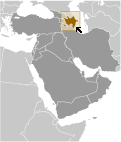World Atlas: Azerbaijan. On this page you can see the map, country flag and many detailed information about the people, history and economy of Azerbaijan.

Here you can find online selected information about the geography, inhabitants, government, economy and history of Azerbaijan. Included are selected statistics, an overview map and the detailed map of Azerbaijan. But let's start with the flag of Azerbaijan here:
Azerbaijan - Overview:
What you should know about Azerbaijan? Let's start with this: Azerbaijan - a nation with a majority-Turkic and majority-Shia Muslim population - was briefly independent (from 1918 to 1920) following the collapse of the Russian Empire; it was subsequently incorporated into the Soviet Union for seven decades. Azerbaijan has yet to resolve its conflict with Armenia over Nagorno-Karabakh, a primarily ethnic Armenian-populated region that Moscow recognized in 1923 as an autonomous republic within Soviet Azerbaijan after Armenia and Azerbaijan disputed the territory's status. Armenia and Azerbaijan reignited their dispute over the area in 1988; the struggle escalated militarily after both countries attained independence from the Soviet Union in 1991. By May 1994, when a cease-fire took hold, ethnic Armenian forces held not only Nagorno-Karabakh but also seven surrounding provinces in the territory of Azerbaijan. The OSCE Minsk Group, co-chaired by the US, France, and Russia, is the framework established to mediate a peaceful resolution of the conflict. Corruption in the country is widespread, and the government, which eliminated presidential term limits in a 2009 referendum and approved extending presidential terms from 5 to 7 years in 2016, has been accused of authoritarianism. Although the poverty rate has been reduced and infrastructure investment has increased substantially in recent years due to revenue from oil and gas production, reforms have not adequately addressed weaknesses in most government institutions, particularly in the education and health sectors, as well as the court system.
Geography of Azerbaijan
 Where on the globe is Azerbaijan? The location of this country is Southwestern Asia, bordering the Caspian Sea, between Iran and Russia, with a small European portion north of the Caucasus range. Total area of Azerbaijan is 86,600 sq km, of which 82,629 sq km is land. So this is not a large country. How could we describe the terrain of the country? This way: large, flat Kur-Araz Ovaligi (Kura-Araks Lowland, much of it below sea level) with Great Caucasus Mountains to the north, Qarabag Yaylasi (Karabakh Upland) to the west; Baku lies on Abseron Yasaqligi (Apsheron Peninsula) that juts into Caspian Sea. The lowest point of Azerbaijan is Caspian Sea -28 m, the highest point Bazarduzu Dagi 4,466 m. And the climate is dry, semiarid steppe.
Where on the globe is Azerbaijan? The location of this country is Southwestern Asia, bordering the Caspian Sea, between Iran and Russia, with a small European portion north of the Caucasus range. Total area of Azerbaijan is 86,600 sq km, of which 82,629 sq km is land. So this is not a large country. How could we describe the terrain of the country? This way: large, flat Kur-Araz Ovaligi (Kura-Araks Lowland, much of it below sea level) with Great Caucasus Mountains to the north, Qarabag Yaylasi (Karabakh Upland) to the west; Baku lies on Abseron Yasaqligi (Apsheron Peninsula) that juts into Caspian Sea. The lowest point of Azerbaijan is Caspian Sea -28 m, the highest point Bazarduzu Dagi 4,466 m. And the climate is dry, semiarid steppe.
Inhabitants of Azerbaijan
Let's take a look how many people live in Azerbaijan. The number is: 9,961,396 (July 2017 est.). So this is not very populous country. Who lives here? Azerbaijani 91.6%, Lezghin 2%, Russian 1.3%, Armenian 1.3%, Talysh 1.3%, other 2.4%. What are the languages in Azerbaijan? Azerbaijani (Azeri) (official) 92.5%, Russian 1.4%, Armenian 1.4%, other 4.7% (2009 est.). And the religions: Muslim 96.9% (predominantly Shia), Christian 3%, other . How old are the people in average? 31.3 years. We have to add that this number is the median - so one half of the people is older than this, one half is younger. And what is their life expectancy (at birth)? This: 72.8 years. Where the people live in Azerbaijan? Here: highest population density is found in the far eastern area of the county, in and around Baku; apart from smaller urbanized areas, the rest of the country has a fairly light and evenly distributed population. The major urban areas of Azerbaijan are: BAKU (capital) 2.374 million (2015).
Government and Economy of Azerbaijan
The capital of Azerbaijan is Baku (Baki, Baky) and the government type presidential republic. Let's take a look at the administrative divisions - 66 rayons (rayonlar; rayon - singular), 11 cities (saharlar; sahar - singular);. Regarding the economy of Azerbaijan, important industrial products are petroleum and petroleum products, natural gas, oilfield equipment; steel, iron ore; cement; chemicals and petrochemicals; textiles. Important agricultural products are fruit, vegetables, grain, rice, grapes, tea, cotton, tobacco; cattle, pigs, sheep, goats. The most important export commodities are oil and gas roughly 90%, machinery, foodstuffs, cotton and the most important export partners are Italy 19.9%, Germany 10.5%, France 8%, Indonesia 5.8%, Czech Republic 5.2% (2016). The most important import commodities are machinery and equipment, foodstuffs, metals, chemicals and the most important import partners are Russia 15.7%, Turkey 12.5%, US 9.6%, Germany 7.5%, Italy 6.7%, Japan 6.2%, China 5.4%, UK 5.4% (2016). How rich is Azerbaijan and how rich are people in this country? The most important number here is GDP per capita (PPP): $17,400 (2017 est.). This is quite good. Let's add that this means Gross Domestic Product per person, which is recalculated with respect to the relative cost of local goods and services. And one more important number - population below poverty line: 4.9% (2015 est.).